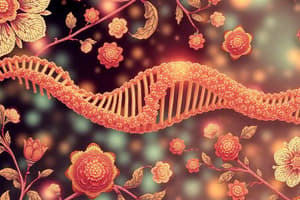Podcast
Questions and Answers
What is the primary substance where cellular processes occur within a cell?
What is the primary substance where cellular processes occur within a cell?
- Nucleus
- Cytoplasm (correct)
- Cell wall
- Endoplasmic reticulum
Which of the following options is NOT a type of biomolecule?
Which of the following options is NOT a type of biomolecule?
- Carbohydrates
- Proteins
- Hydrogen (correct)
- Lipids
What role do enzymes typically play in biochemical reactions?
What role do enzymes typically play in biochemical reactions?
- They consume energy
- They change the pH
- They act as catalysts (correct)
- They form cellular structures
Which of the following components is found within the cytoplasm?
Which of the following components is found within the cytoplasm?
What is the function of ribosomes in a cell?
What is the function of ribosomes in a cell?
Flashcards
Cytoplasm
Cytoplasm
The fluid inside a cell that surrounds the organelles.
Sequence
Sequence
A series of steps or instructions that are followed in a specific order.
Enzyme
Enzyme
A type of protein that speeds up chemical reactions in a cell.
Study Notes
Gene Expression & Transcription in Eukaryotes
- Eukaryotic genes are composed of coding sequences (exons) interrupted by non-coding sequences (introns).
- The average gene spans 10-16 kb of DNA.
- Each gene possesses exons, start signals, stop signals, and regulatory control elements.
- The human genome contains an estimated 30,000 to 120,000 genes.
- Genes are the fundamental units of inheritance determining all phenotypes.
- Genes contain instructions for specific proteins, providing the blueprint for cellular proteins.
Objectives
- Gene Structure
- Gene Expression
- Types of Genes
- Post-transcriptional modifications (RNA splicing, 3' polyadenylation, 5' capping)
Genes
- Genes are segments of DNA containing instructions for a specific protein.
- A promoter is a region of DNA initiating transcription of a specific gene. Promoters are located upstream of the sense strand. They consist of the conserved eukaryotic promoter regions which include the CAAT box, TATA box, GC box, and CAP site.
- The size of promoters can range from 100-1000 base pairs.
- Gene expression is the process converting genetic information into the structures/functions of a cell through the production of biological molecules (proteins or RNA).
Gene Expression
- Gene expression is controlled at various points during the sequence leading to protein synthesis.
- The DNA strand used as a template for transcription is called the antisense strand. The mRNA produced is a copy of the sense strand
- RNA polymerase is essential in the process of transcription.
- Transcription ends with a specific stopping sequence.
Central Dogma
- Transcription: DNA → RNA
- Translation: RNA→ Protein.
Types of Genes
- Constitutive Genes (Housekeeping Genes): These are expressed at a constant rate and are not subjected to regulation (e.g., enzymes of glycolysis).
- Regulated Genes: These are expressed only under certain conditions (e.g., insulin gene expression in the pancreas).
Flow of genetic information in Prokaryotes vs. Eukaryotes
- Prokaryotic transcription and translation occur in the cytoplasm simultaneously.
- Eukaryotic transcription occurs in the nucleus, while translation occurs in the cytoplasm.
Eukaryotic Promoter
- Promoter is a region of DNA initiating transcription.
- Promoters are located near the transcription start sites of genes on the same strand and upstream from the sense strand (towards the 5' region).
Eukaryotic Gene Promoter Sequences
- Sequences within the eukaryotic promoter region are recognized by RNA polymerase II.
- Sequences range from 45 to 55 bases long.
- Important elements in promoters include the TATA box and the Hogness box.
Enhancer Sequences
- Enhancers are regulatory DNA sequences influencing transcription.
- Enhancers can be located upstream, downstream, or within the coding region, and may be thousands of nucleotides away from the target gene.
- They bind to transcription factors (activators) increasing the likelihood of gene transcription.
Silencers
- Transcription factors (repressors) bind to areas called silencer regions to reduce the rate of transcription.
Transcription (Synthesis of RNA)
- Transcription is the process where DNA is transcribed into mRNA, carrying instructions for proteins.
Messenger RNA (mRNA)
- mRNA is used to create blueprints for protein production.
- mRNA carries information from DNA for protein synthesis.
Reverse Transcription
- Reverse transcription is the synthesis of DNA from an RNA template catalyzed by reverse transcriptase.
- Retroviruses (e.g., HIV, hepatitis C) utilize reverse transcription to insert their genetic material into the host genome.
Transcription in Eukaryotes (Second Step): Post-transcriptional modifications or gene processing
- The primary RNA transcript is modified into mature RNA.
- Modifications: 5' capping, 3' polyadenylation, and RNA splicing; occurring in the nucleus before translation in the cytoplasm.
Capping
- 7-methylguanosine (m7G) is added to the 5' end of mRNA.
- This protects the mRNA from degradation.
- A phosphatase enzyme is involved in capping as it removes the 5′ phosphate enabling the addition of the cap.
Cleavage and Polyadenylation
- The RNA molecule undergoes cleavage at the 3' end.
- Adenine residues are added to form a poly (A) tail, which protects the mRNA from degradation.
RNA Splicing
- Introns are non-coding sections removed from the primary RNA transcript.
- Exons are the remaining coding sections joined together.
Synthesis of Messenger RNA (mRNA) in Eukaryotes
- The primary transcribed mRNA molecule undergoes processing (5' capping, 3′ polyadenylation, splicing).
- Mature mRNA then exits the nucleus for translation.
Clinical Correlates
- Defects in mRNA splicing of the β-globin gene cause β-thalassemia.
- Mutations in splicing lead to aberrant transcripts that are degraded.
- Homozygous mutations result in severe transfusion-dependent anemia.
Synthesis of ribosomal RNA (rRNA)
- rRNA participates in ribosome formation.
- rRNA undergoes methylation and trimming before assembling with ribosome subunits.
Synthesis of transfer RNA (tRNA)
- tRNA translates the genetic code into proteins.
- RNA polymerase III is involved in producing tRNA.
- tRNA precursors undergo intron removal, nucleotide modifications, and addition of a CCA sequence at the 3’ end.
Studying That Suits You
Use AI to generate personalized quizzes and flashcards to suit your learning preferences.




